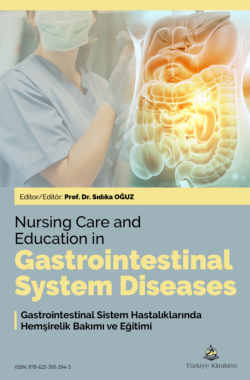Nursing Care and Education in Diagnostic Methods of Gastroenterology
Sıdıka OĞUZa , Dilek GELİNb,c
aMarmara University Faculty of Health Sciences, Department of Nursing, Division of Internal Medicine Nursing, İstanbul, Türkiye
bMarmara University Institute of Health Sciences, Department of Nursing, EEG Unit, İstanbul, Türkiye
cKayseri City Hospital, Kayseri, Türkiye
Oğuz S, Gelin D. Nursing care and education in diagnostic methods of gastroenterology. In: Oğuz S, ed. Nursing Care and Education in Gastrointestinal System Diseases. 1st ed. Ankara: Türkiye Klinikleri; 2024.
ABSTRACT
Gastrointestinal system diseases are frequently encountered in societies and adversely affect the quality of life of societies. Delay in the diagnosis of these diseases leads to serious complications and consequently increases morbidity and mortality. Symptoms such as nausea, vomiting, abdominal pain, dyspepsia, halitosis, flatulence, diarrhea, constipation and fecal incontinence are observed. Laboratory tests are performed to determine the patient’s metabolic and disease status. Radiologic tests are essential in the diagnosis of gastrointestinal system diseases and are performed in specialized units. The nurse is involved in the diagnosis and care of these symptoms. They perform the necessary nursing practices before, during and after laboratory and radiologic tests. This chapter was prepared to talk about diagnostic tests in gastrointestinal system diseases and the significance of nursing care in these tests.
Keywords: Gastrointestinal system diseases; laboratory and radiologic tests; nursing care
Kaynak Göster
Referanslar
- Enç N, Can G, Tülek Z, Uysal H, Demir M, Alkan HÖ. Enç N, editor. Internal medicine nursing. 2nd ed. Nobel Medical Bookstores Tic. Ltd. Sti.; 2017. p:183.
- Kaptan G, Dedeli Ö. Kaptan G, Internal medicine nursing concepts and theories from theory to practice.1st ed. Istanbul Medikal Publishing Ltd. Sti.; 2012. p: 263-320. [Crossref] [PubMed] [PMC]
- Ovayolu N, Ovayolu Ö. Basic internal medicine nursing and chronic diseases with different dimensions. 2nd ed. Cukurova Nobel Bookstores. Tic. Ltd. Sti.; 2017. p:161-88.
- Wang R, Li Z, Liu S, Zhang D. Global, regional, and national burden of 10 digestive diseases in 204 countries and territories from 1990 to 2019. Front Public Health. 2023;11:1061453. [Crossref] [PubMed] [PMC]
- Blachier M, Leleu H, Peck-Radosavljevic M, Valla DC, Roudot-Thoraval F. The burden of liver disease in Europe: a review of available epidemiological data. J Hepatol. 2013;58(3):593-608. [Crossref] [PubMed]
- Introduction to Diagnosis of Digestive Disorders. [Accessed: November 01, 2023]. Access link: [Link]
- Huang S, Zhou C, Wang B, Jiang J, Gao A, Peng J, et al. Recent advances in oral drug delivery materials for targeted diagnosis or treatment of gastrointestinal diseases. Journal of Drug Delivery Science and Technology. 2023; 1773-2247. [Crossref]
- Karadakovan A, Aslan FE. Care in internal and surgical diseases. 6th Edition. Academician Medical Bookstore; 2022. p:685-754.
- Gans SL, Stoker J, Boermeester MA. Plain abdominal radiography in acute abdominal pain; past, present, and future. International Journal of General Medicine. 2012;525-33. [Crossref] [PubMed] [PMC]
- Elmas, N. Basic Principles of Contrast-enhanced Digestive Tract Examination and Case Examples. Trd Sem. 2017;5(1):170-84. [Crossref]
- Farrell M. Smeltzer and Bare's Textbook of Medical-Surgical Nursing: Volume 1 and 2. Lippincott Williams & Wilkins North Ryde, NSW; 2017. p.923-8.
- Özdemir FA, Can G. Constipation. In: Oguz S, Unver V, Camci G, Kocatepe V, eds. Symptom management and nursing. Istanbul: Istanbul Medical Bookstores; 2023. p.328.
- Hinkle JL, Cheever KH. Brunner and Suddarth's Textbook of Medical-Surgical Nursing. 14th ed. Wolters Kluwer India Pvt Ltd; 2018. p.3273-92.
- Benjamin I, Unal S (Translation editor). Cecil Essentials of Medicine. 9th ed. Güneş Medical Bookstores; 2016. p:389-95,442.
- Loscalzo J, Fauci AS, Kasper DL, Hauser SL, Longo, DL, Jameson JL. Harrison's Principles of Internal Medicine. McGraw-Hill Companies; 2022. p:8758-832.
- Karahan Ö, Cingi A, Şimşek ODG, Sevinç, ODB. Gastrointestinal System Endoscopy.1st ed. Pelin Offset Letterpress Printing and Tic. Ltd. Sti.;2016. p.75-7.
- Keogh JE, DiGiulio M. Medical-Surgical Nursing Demystified. 3rd ed. McGraw-Hill; 2019. p:179-200.
- T.C. Ministry of Health Tepecik Training and Research Hospital Gastroenterology Diseases Nursing Care Guide. 2011. p:40-3.
- Harding MM, Kwong J, Roberts D, Hagler D, Reinisch C. Lewis's medical-surgical nursing. 12th ed. Elsevier Health Sciences; 2022. p:3161-73.
- Çevik L. The effect of video-assisted training given before ERCP procedure on anxiety level and satisfaction. Istanbul: Medipol University Institute of Health Sciences; 2019. p:15-7.
- Honan, L. Focus on adult health: medical-surgical nursing. Two Edition. Lippincott Williams & Wilkins; 2019.p:1732-4.
- Williams LS, Hopper PD. Understanding Medical Surgical Nursing. 50th ed. FA Davis Company; 2015. p.701-9.
- Plumb AA, Phillips P, Spence G, Mallett S, Taylor SA, Halligan S, et al. Increasing navigation speed at endoluminal CT colonography reduces colonic visualization and polyp identification. Radiology. 2017;284(2):413-22. [Crossref] [PubMed] [PMC]

